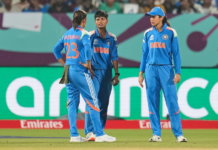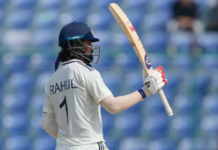Sam Collins’s documentary Death of a Gentleman charts the decline and fall of Test cricket as we know it. He tells Tom Fordy that the actions of a select few are depriving us all one of the world’s great games
When I was invited to Lord’s to interview journalist and cricket devotee Sam Collins about his documentary Death of a Gentleman, I was excited. It was the second day of the England Vs Australia Test, the sun was shining, and the atmosphere agreeable – plus I’d never been to the “Home of Cricket” before.
Hopefully, I thought, Sam’s film – which began as a well-meaning look at the dying art of Test cricket – had won him some friends on the England and Wales Cricket Board. Perhaps they’ve rewarded him with some VIP seats, a bottle of bubbly, and a plate of complimentary cucumber sandwiches. Maybe I’ll even get to share some and hang around for a few hours of the match.
But when I get to Lord’s, I find Sam not enjoying the game in luxury, but outside, handing out flyers with a lion wearing a #ChangeCricket t-shirt. I quickly realise his film has made him absolutely no friends on the England and Wales Cricket Board. In fact, quite the opposite.
Along with fellow journalist Jarrod Kimber, Sam’s investigation found that away from the strip, Test cricket is tangled in a web of greed and manipulation, one that threatens to choke the life from the game once and for all. As ever, the cause is money – more specifically, the $1.9billion tied up in television rights and the huge pay days associated with the Indian Premier League.
Given our hallowed surroundings, my first question to him has a sacrilegious air. If Test cricket is so fallible, why try to save it in the first place?
“It’s a contest between bat and ball,” he says. “There are stories, subplots that develop over a period of time, all these different nuances … it’s like a friendship. There’s something unique about test cricket. And in a world of homogenization, when a game has something that nothing else has, you want to preserve that.”
People tend to assume everything that’s traditional and much loved is somehow on the way out, in that “nothing’s what it used to be” sort of way. But what was Sam’s first inkling that Test cricket may actually be dying?
“Everyone’s always talked about it,” he says. “There’s a sense of insecurity about cricket, because of the perception that it’s boring. But the reality is that while satellite TV has brought more and more money into the game, Test cricket doesn’t make the money the shorter formats like Twenty20 make. It’s like plate tectonics. In an ideal world everything would just work together, but they’re rubbing against each other causing friction.”
The impact of Twenty20 has knocked Test cricket for a six, particularly with the creation of the Indian Premier League. The format, which as Sam says, is what the uninitiated would call “cricket without the boring bits”, is three hours of ball-smashing action, with a guaranteed result and American Football-style pizzazz.
As a formula, it’s perfect for taking cricket to the masses. It also offers players the kind of money Premier League footballers are paid, luring them away from the international game and creating a huge disparity between Test and Twenty20 cricket.
“It’s not about India being bad or the IPL being bad,” says Sam. “It’s about the phenomenon of Twenty20 distorting finances to the extent that the rest of cricket cannot cope with it.”
Indeed, it’s not just India – England and Australia are in on the act too. As Death of a Gentleman argues, the fundamental problem with Test cricket is that it’s being controlled by – and for the interests of – the sport’s three biggest nations.
“The other 102 countries that play the game are getting left behind,” says Sam. “The seven smaller Test-playing countries can’t afford for their players not to play Test cricket, but the three big countries aren’t interested in playing against them, and the other 95 countries who want to play Test cricket aren’t allowed. Their funding has being diminished and opportunities to play in global events decreased.”
With the biggest TV revenues going to the game’s three leading nations, teams such as the West Indies – who for years dazzled the world in Test cricket – have all disappeared from high-profile Tests.
The film reveals much more: apparently shadowy International Cricket Council meetings, in which the fate of a sport played and watched by 1billion people is decided by a handful of powerful men; a report by former Lord Chief Justice Harry Woolf, which called for independent governance, seemingly all but ignored; and the issue of cricket entering the Olympics batted away, despite the money and exposure it would offer smaller cricketing nations (crucial at a time when the ICC is reducing the Cricket World Cup from 14 teams to just 10).
At the centre of it all are a cast of colourful characters, all of whom take a starring role in the film: Lalit Modi, who masterminded the IPL and turned it into a $4billion industry, only to be ousted from the Board for Control of Cricket in India and exiled to London in a storm of controversy; Giles Clarke, the chairman of the ECB, who comes across like a comedy baddie just waiting for panto season to start up again; and, most of all, ICC chairman Narayanaswami Srinivasan, one-time owner of the IPL’s Chennai Super Kings, former member of the BCCI, and father-in-law to a convicted match fixer (when Srinivasan refused to step down from the ICC, the Supreme Court dubbed him “nauseating for cricket”).
Death of a Gentleman has become more than just a film. It’s transformed into a campaign to challenge what’s happening and ultimately change cricket.
“It’s the greatest game there is,” Sam says. “I just want it to survive. If we can raise awareness to some of the people in Lord’s, or the people outside, we can do what’s been done with Fifa and in other areas so successfully.”
It’s hard going, though. Sam’s offer to screen the film to the MCC World Cricket Committee was turned down, for fear of rocking the boat, and efforts to contact the head of women’s cricket in England were refused by the ECB. Which is how Sam now finds himself outside of Lord’s, doing it the hard way, flyer-by-flyer.
“We know we need to take this story to a wider audience,” he says, “to people who aren’t passionate cricket fans, but can look at it objectively. It’s the second biggest sport in the world. Its television is worth 1.9billion dollars, and what happens to those dollars is being decided by three countries, without any without any transparency or accountability.”
It’s just not cricket, as they say.















